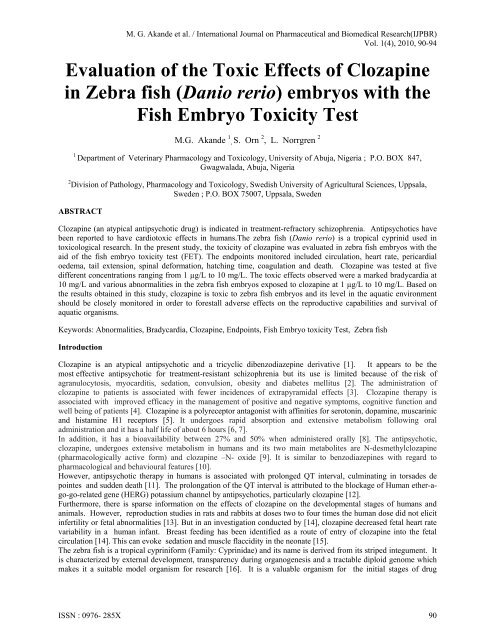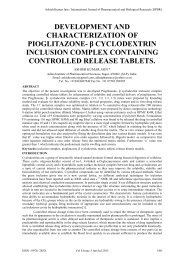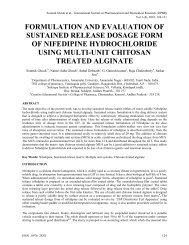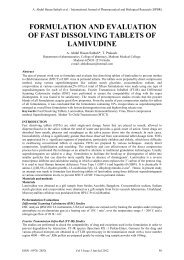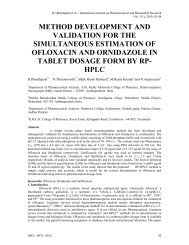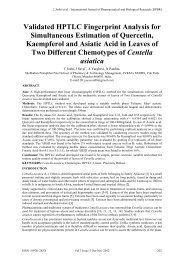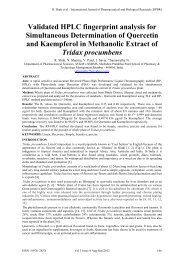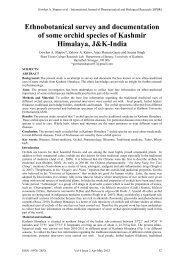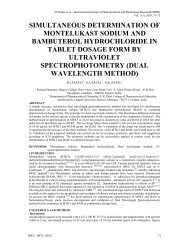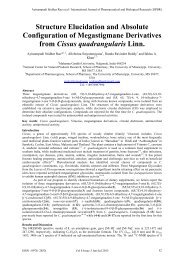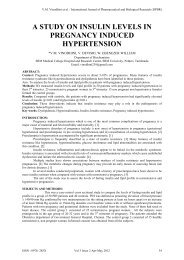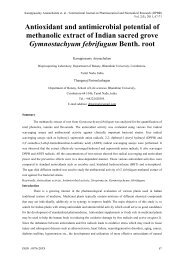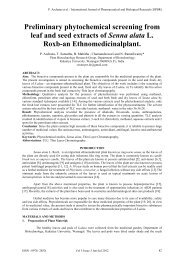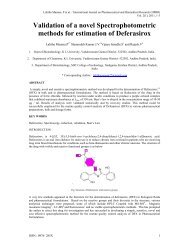Evaluation of the Toxic Effects of Clozapine in Zebra fish - KEJA ...
Evaluation of the Toxic Effects of Clozapine in Zebra fish - KEJA ...
Evaluation of the Toxic Effects of Clozapine in Zebra fish - KEJA ...
Create successful ePaper yourself
Turn your PDF publications into a flip-book with our unique Google optimized e-Paper software.
M. G. Akande et al. / International Journal on Pharmaceutical and Biomedical Research(IJPBR)<br />
Vol. 1(4), 2010, 90-94<br />
<strong>Evaluation</strong> <strong>of</strong> <strong>the</strong> <strong>Toxic</strong> <strong>Effects</strong> <strong>of</strong> <strong>Clozap<strong>in</strong>e</strong><br />
<strong>in</strong> <strong>Zebra</strong> <strong>fish</strong> (Danio rerio) embryos with <strong>the</strong><br />
Fish Embryo <strong>Toxic</strong>ity Test<br />
M.G. Akande 1 , S. Orn 2 , L. Norrgren 2<br />
1<br />
Department <strong>of</strong> Veter<strong>in</strong>ary Pharmacology and <strong>Toxic</strong>ology, University <strong>of</strong> Abuja, Nigeria ; P.O. BOX 847,<br />
Gwagwalada, Abuja, Nigeria<br />
2 Division <strong>of</strong> Pathology, Pharmacology and <strong>Toxic</strong>ology, Swedish University <strong>of</strong> Agricultural Sciences, Uppsala,<br />
Sweden ; P.O. BOX 75007, Uppsala, Sweden<br />
ABSTRACT<br />
<strong>Clozap<strong>in</strong>e</strong> (an atypical antipsychotic drug) is <strong>in</strong>dicated <strong>in</strong> treatment-refractory schizophrenia. Antipsychotics have<br />
been reported to have cardiotoxic effects <strong>in</strong> humans.The zebra <strong>fish</strong> (Danio rerio) is a tropical cypr<strong>in</strong>id used <strong>in</strong><br />
toxicological research. In <strong>the</strong> present study, <strong>the</strong> toxicity <strong>of</strong> clozap<strong>in</strong>e was evaluated <strong>in</strong> zebra <strong>fish</strong> embryos with <strong>the</strong><br />
aid <strong>of</strong> <strong>the</strong> <strong>fish</strong> embryo toxicity test (FET). The endpo<strong>in</strong>ts monitored <strong>in</strong>cluded circulation, heart rate, pericardial<br />
oedema, tail extension, sp<strong>in</strong>al deformation, hatch<strong>in</strong>g time, coagulation and death. <strong>Clozap<strong>in</strong>e</strong> was tested at five<br />
different concentrations rang<strong>in</strong>g from 1 µg/L to 10 mg/L. The toxic effects observed were a marked bradycardia at<br />
10 mg/L and various abnormalities <strong>in</strong> <strong>the</strong> zebra <strong>fish</strong> embryos exposed to clozap<strong>in</strong>e at 1 µg/L to 10 mg/L. Based on<br />
<strong>the</strong> results obta<strong>in</strong>ed <strong>in</strong> this study, clozap<strong>in</strong>e is toxic to zebra <strong>fish</strong> embryos and its level <strong>in</strong> <strong>the</strong> aquatic environment<br />
should be closely monitored <strong>in</strong> order to forestall adverse effects on <strong>the</strong> reproductive capabilities and survival <strong>of</strong><br />
aquatic organisms.<br />
Keywords: Abnormalities, Bradycardia, <strong>Clozap<strong>in</strong>e</strong>, Endpo<strong>in</strong>ts, Fish Embryo toxicity Test, <strong>Zebra</strong> <strong>fish</strong><br />
Introduction<br />
<strong>Clozap<strong>in</strong>e</strong> is an atypical antipsychotic and a tricyclic dibenzodiazep<strong>in</strong>e derivative [1]. It appears to be <strong>the</strong><br />
most effective antipsychotic for treatment-resistant schizophrenia but its use is limited because <strong>of</strong> <strong>the</strong> risk <strong>of</strong><br />
agranulocytosis, myocarditis, sedation, convulsion, obesity and diabetes mellitus [2]. The adm<strong>in</strong>istration <strong>of</strong><br />
clozap<strong>in</strong>e to patients is associated with fewer <strong>in</strong>cidences <strong>of</strong> extrapyramidal effects [3]. <strong>Clozap<strong>in</strong>e</strong> <strong>the</strong>rapy is<br />
associated with improved efficacy <strong>in</strong> <strong>the</strong> management <strong>of</strong> positive and negative symptoms, cognitive function and<br />
well be<strong>in</strong>g <strong>of</strong> patients [4]. <strong>Clozap<strong>in</strong>e</strong> is a polyreceptor antagonist with aff<strong>in</strong>ities for seroton<strong>in</strong>, dopam<strong>in</strong>e, muscar<strong>in</strong>ic<br />
and histam<strong>in</strong>e H1 receptors [5]. It undergoes rapid absorption and extensive metabolism follow<strong>in</strong>g oral<br />
adm<strong>in</strong>istration and it has a half life <strong>of</strong> about 6 hours [6, 7].<br />
In addition, it has a bioavailability between 27% and 50% when adm<strong>in</strong>istered orally [8]. The antipsychotic,<br />
clozap<strong>in</strong>e, undergoes extensive metabolism <strong>in</strong> humans and its two ma<strong>in</strong> metabolites are N-desmethylclozap<strong>in</strong>e<br />
(pharmacologically active form) and clozap<strong>in</strong>e –N- oxide [9]. It is similar to benzodiazep<strong>in</strong>es with regard to<br />
pharmacological and behavioural features [10].<br />
However, antipsychotic <strong>the</strong>rapy <strong>in</strong> humans is associated with prolonged QT <strong>in</strong>terval, culm<strong>in</strong>at<strong>in</strong>g <strong>in</strong> torsades de<br />
po<strong>in</strong>tes and sudden death [11]. The prolongation <strong>of</strong> <strong>the</strong> QT <strong>in</strong>terval is attributed to <strong>the</strong> blockage <strong>of</strong> Human e<strong>the</strong>r-ago-go-related<br />
gene (HERG) potassium channel by antipsychotics, particularly clozap<strong>in</strong>e [12].<br />
Fur<strong>the</strong>rmore, <strong>the</strong>re is sparse <strong>in</strong>formation on <strong>the</strong> effects <strong>of</strong> clozap<strong>in</strong>e on <strong>the</strong> developmental stages <strong>of</strong> humans and<br />
animals. However, reproduction studies <strong>in</strong> rats and rabbits at doses two to four times <strong>the</strong> human dose did not elicit<br />
<strong>in</strong>fertility or fetal abnormalities [13]. But <strong>in</strong> an <strong>in</strong>vestigation conducted by [14], clozap<strong>in</strong>e decreased fetal heart rate<br />
variability <strong>in</strong> a human <strong>in</strong>fant. Breast feed<strong>in</strong>g has been identified as a route <strong>of</strong> entry <strong>of</strong> clozap<strong>in</strong>e <strong>in</strong>to <strong>the</strong> fetal<br />
circulation [14]. This can evoke sedation and muscle flaccidity <strong>in</strong> <strong>the</strong> neonate [15].<br />
The zebra <strong>fish</strong> is a tropical cypr<strong>in</strong>iform (Family: Cypr<strong>in</strong>idae) and its name is derived from its striped <strong>in</strong>tegument. It<br />
is characterized by external development, transparency dur<strong>in</strong>g organogenesis and a tractable diploid genome which<br />
makes it a suitable model organism for research [16]. It is a valuable organism for <strong>the</strong> <strong>in</strong>itial stages <strong>of</strong> drug<br />
ISSN : 0976- 285X 90
M. G. Akande et al. / International Journal on Pharmaceutical and Biomedical Research(IJPBR)<br />
Vol. 1(4), 2010, 90-94<br />
discovery [17]. <strong>Zebra</strong> <strong>fish</strong> embryos are permeable to drug molecules <strong>in</strong> suitable media and hence <strong>the</strong>ir use for drug<br />
toxicity test<strong>in</strong>g. Also, zebra <strong>fish</strong> are currently be<strong>in</strong>g used for teratogenicity assays for evaluat<strong>in</strong>g <strong>the</strong> teratogenic<br />
potential <strong>of</strong> chemicals [18]. It has a small size and this is advantageous <strong>in</strong> terms <strong>of</strong> hold<strong>in</strong>g space, husbandry costs<br />
and drug doses [19]. Also, whole-body section<strong>in</strong>g and histological evaluation <strong>of</strong> <strong>the</strong> zebra <strong>fish</strong> is feasible for<br />
research purposes.<br />
Residues <strong>of</strong> clozap<strong>in</strong>e have been detected <strong>in</strong> sludge from Swedish sewage effluents [20] but <strong>the</strong>re is limited aquatic<br />
ecotoxicity data on clozap<strong>in</strong>e. Therefore this study was conducted <strong>in</strong> order to <strong>in</strong>vestigate <strong>the</strong> toxicity <strong>of</strong> clozap<strong>in</strong>e to<br />
aquatic organisms with <strong>the</strong> use <strong>of</strong> zebra <strong>fish</strong> (Danio rerio) embryos as model organisms. The <strong>fish</strong> embryo toxicity<br />
test [21] was employed <strong>in</strong> this study.<br />
Materials and Methods<br />
Experimental animals<br />
Adult zebra <strong>fish</strong> (Danio rerio) were procured from a local supplier <strong>in</strong> Uppsala, Sweden and were allowed to adapt to<br />
laboratory conditions for 4 weeks before <strong>the</strong> commencement <strong>of</strong> <strong>the</strong> project. The study was conducted at <strong>the</strong> Division<br />
<strong>of</strong> Pathology, Pharmacology and <strong>Toxic</strong>ology, Swedish University <strong>of</strong> Agricultural Sciences, Uppsala, Sweden.<br />
The animals were kept <strong>in</strong> aquaria with<strong>in</strong> a temperated laboratory at 26 ± 1 0 C and a 12 – h light /dark cycle was<br />
ma<strong>in</strong>ta<strong>in</strong>ed. Standardized water (ISO 7346 – 1, 1996) was used for <strong>the</strong> ma<strong>in</strong>tenance <strong>of</strong> <strong>the</strong> adult zebra <strong>fish</strong>. It was<br />
prepared from deionised water and <strong>the</strong> follow<strong>in</strong>g salts were added: CaCl 2 x 2H 2 O (117.6 mg/L), MgSO 4 x 7H 2 O<br />
(49.3mg/L), NaHCO 3 (25.9mg/L) and KCl (2.3 mg/L) (Sigma Aldrich Sweden AB) to produce standardized water.<br />
The adult zebra <strong>fish</strong> were fed with newly hatched Artemia nauplii (San Francisco Bay brand) 2 times daily.<br />
The animals were cared for <strong>in</strong> accordance with <strong>the</strong> guide to <strong>the</strong> care and use <strong>of</strong> experimental animals. The use <strong>of</strong> <strong>the</strong><br />
animals was reviewed and approved by <strong>the</strong> Swedish University <strong>of</strong> Agricultural Sciences Animal Care Review<br />
Committee.<br />
The Fish Embryo toxicity Test (FET)<br />
The eggs were obta<strong>in</strong>ed from adult male and female zebra <strong>fish</strong> placed <strong>in</strong> cone shaped breed<strong>in</strong>g funnels for spawn<strong>in</strong>g<br />
<strong>in</strong> a ratio <strong>of</strong> 2:1. The funnels were filled with 20 – 25 liters <strong>of</strong> standardized water. The eggs were obta<strong>in</strong>ed from <strong>the</strong><br />
breed<strong>in</strong>g funnels <strong>the</strong> follow<strong>in</strong>g day between 30 and 60 m<strong>in</strong>utes after light was switched on <strong>in</strong> <strong>the</strong> laboratory. The<br />
brood <strong>fish</strong> were <strong>the</strong>reafter returned to <strong>the</strong> aquaria.<br />
Stock solutions <strong>of</strong> clozap<strong>in</strong>e (Sigma Aldrich Sweden AB) were prepared <strong>in</strong> dimethylsulphoxide (>99.5% DMSO;<br />
Merck) and <strong>the</strong>n diluted 1:1000 <strong>in</strong> standardized water to exposure concentrations <strong>of</strong> 1 µg/L, 10 µg/L, 100 µg/L, 1<br />
mg/L and 10 mg/L. Standardized water and DMSO were used as negative controls. The concentration <strong>of</strong> <strong>the</strong> carrier<br />
DMSO was 0.1% <strong>in</strong> <strong>the</strong> f<strong>in</strong>al test and negative control solutions. A mixture <strong>of</strong> musk ketone 50 μg/L (Sigma Aldrich<br />
Sweden AB) and 7.6 mg/L phenylthiourea (Sigma Aldrich Sweden AB) was used as positive control for bradycardia<br />
and <strong>in</strong>hibition <strong>of</strong> pigmentation respectively. Newly laid eggs were placed <strong>in</strong> Petri dishes conta<strong>in</strong><strong>in</strong>g <strong>the</strong> test solutions<br />
with <strong>the</strong> aid <strong>of</strong> a pipette.<br />
The eggs were exam<strong>in</strong>ed <strong>in</strong> a stereo microscope for <strong>the</strong> selection <strong>of</strong> eggs that had reached <strong>the</strong> four – cell stage. For<br />
each exposure concentration, 12 eggs were selected and transferred <strong>in</strong>dividually to 96 micro – well plates (Costar,<br />
Corn<strong>in</strong>g Incorporated, USA) with 250 μL <strong>of</strong> <strong>the</strong> test solutions. The plates were covered with parafilm and <strong>the</strong>n kept<br />
at 26 0 C <strong>in</strong> a 12 – h light/dark cycle. The exam<strong>in</strong>ation <strong>of</strong> <strong>the</strong> eggs was carried out with <strong>the</strong> aid <strong>of</strong> a stereo microscope<br />
at 24, 48 and 144 hours post fertilization (hpf). In order to prevent <strong>the</strong>rmal stress to <strong>the</strong> embryos, microscopic<br />
exam<strong>in</strong>ation was performed with a light source equipped with a fiber optic cable. Photos <strong>of</strong> <strong>the</strong> micro – well plates<br />
were taken with a mounted digital <strong>in</strong>terval timer camera (Canon Power Shot Pro I) once every hour from 48 to 144<br />
hours.<br />
The various endpo<strong>in</strong>ts monitored <strong>in</strong>cluded tail extension (24h), spontaneous movement (24h), pigmentation (24h),<br />
eye development (24 and 48h), coagulation (24 and 48h), heart rate (48h), pericardial oedema (48h), circulation<br />
(48h), sp<strong>in</strong>al deformation (144h) and hatch<strong>in</strong>g time (144h). The tail extension <strong>of</strong> <strong>the</strong> zebra <strong>fish</strong> embryos was<br />
measured on a scale <strong>of</strong> one to three, where one denoted <strong>the</strong> complete detachment <strong>of</strong> <strong>the</strong> tail from <strong>the</strong> yolk sac, two<br />
ISSN : 0976- 285X 91
M. G. Akande et al. / International Journal on Pharmaceutical and Biomedical Research(IJPBR)<br />
Vol. 1(4), 2010, 90-94<br />
denoted partial extension while three denoted lack <strong>of</strong> detachment <strong>of</strong> <strong>the</strong> tail from <strong>the</strong> yolk sac. The heart rate was<br />
determ<strong>in</strong>ed by observ<strong>in</strong>g <strong>the</strong> time taken to count 30 heartbeats . The circulation was observed as <strong>the</strong> flow <strong>of</strong> blood <strong>in</strong><br />
<strong>the</strong> caudal artery. The sp<strong>in</strong>al deformation <strong>of</strong> <strong>the</strong> zebra <strong>fish</strong> embryos was measured on a scale <strong>of</strong> one to four, where<br />
one denoted <strong>the</strong> absence <strong>of</strong> deformation, two and three denoted curvature at less than 45 0 and greater than 45 0<br />
respectively while four denoted curvature at several locations. The pigmentation <strong>of</strong> <strong>the</strong> embryos was measured on a<br />
scale <strong>of</strong> one to four, where one denoted full pigmentation, two and three denoted a reduction <strong>in</strong> <strong>the</strong> <strong>in</strong>tensity <strong>of</strong><br />
pigmentation, while four denoted <strong>the</strong> absence <strong>of</strong> pigmentation. Circulation, eye development and oedema were<br />
measured as categorical data (yes or no basis).<br />
In <strong>the</strong> <strong>fish</strong> embryo toxicity test, <strong>the</strong> lethal endpo<strong>in</strong>ts <strong>in</strong>clude coagulation <strong>of</strong> egg, non detachment <strong>of</strong> <strong>the</strong> tail from <strong>the</strong><br />
yolk, lack <strong>of</strong> somites and absence <strong>of</strong> heart beats. The completion <strong>of</strong> gastrulation, eye development, spontaneous<br />
movement, circulation, pigmentation, oedema and heart rate are regarded as sub-lethal endpo<strong>in</strong>ts that could be<br />
measured <strong>in</strong> order to determ<strong>in</strong>e <strong>the</strong> mode <strong>of</strong> action <strong>of</strong> <strong>the</strong> toxic response.<br />
The study was term<strong>in</strong>ated by euthaniz<strong>in</strong>g <strong>the</strong> zebra <strong>fish</strong> <strong>in</strong> trica<strong>in</strong>e methane sulphonate (MS – 222, Apoteket AB,<br />
Sweden).<br />
STATISTICAL ANALYSIS<br />
The data were analyzed by one-way ANOVA followed by Dunnett’s post–hoc test for comparison <strong>of</strong> exposed<br />
groups with controls (DMSO carrier). However, categorical data such as coagulation, circulation and eye formation<br />
were analyzed with <strong>the</strong> Chi Square test. The s<strong>of</strong>tware used for analyz<strong>in</strong>g <strong>the</strong> data were Statview 5.0.1 (SAS Institute<br />
Inc.) and MINITAB release 14 (M<strong>in</strong>itab Inc.). The level <strong>of</strong> significance was set at 0.95 (p < 0.05). Data was<br />
presented as mean ± standard deviation (SD) unless o<strong>the</strong>rwise stated.<br />
RESULTS<br />
Bradycardia and reduced viability were elicited <strong>in</strong> <strong>the</strong> zebra <strong>fish</strong> embryos exposed to clozap<strong>in</strong>e at 10 mg/L (Figure<br />
1). The hatch<strong>in</strong>g time was prolonged <strong>in</strong> zebra <strong>fish</strong> embryos exposed to clozap<strong>in</strong>e at 100 μg/L but this f<strong>in</strong>d<strong>in</strong>g was<br />
not significant. The zebra <strong>fish</strong> embryos exposed to clozap<strong>in</strong>e at 10 mg/L failed to hatch (Table 1). Several<br />
abnormalities such as coagulation, eye defects, pericardial oedema, absence <strong>of</strong> circulation and malformations were<br />
observed <strong>in</strong> zebra <strong>fish</strong> embryos exposed to all <strong>the</strong> concentrations <strong>of</strong> clozap<strong>in</strong>e (1 μg/L – 10 mg/L) (Table 2).<br />
Doses<br />
Table 1. Hatch<strong>in</strong>g time (hours) <strong>of</strong> zebra <strong>fish</strong> embryos exposed to clozap<strong>in</strong>e (1 µg/L – 10 mg/L).<br />
1 µg/L 50.4 ± 2.9<br />
10 µg/L 52 ± 4.3<br />
100 µg/L 55.5 ± 4.9<br />
1 mg/L 52.8 ± 3.9<br />
10 mg/L 0<br />
Control (Standardized water) 51.9 ± 3.4<br />
Control (Dimethyl sulphoxide) 49.9 ± 2.3<br />
Hatch<strong>in</strong>g Time (Mean ± Standard Deviation)<br />
ISSN : 0976- 285X 92
M. G. Akande et al. / International Journal on Pharmaceutical and Biomedical Research(IJPBR)<br />
Vol. 1(4), 2010, 90-94<br />
Table 2. Abnormalities observed after exposure <strong>of</strong> zebra <strong>fish</strong> embryos to clozap<strong>in</strong>e (1 µg/L – 10 mg/L).<br />
Doses<br />
a b c d e f g h<br />
1 µg/L 5 - - - - - - -<br />
10 µg/L 3 - - - - - - -<br />
100 µg/L 1 - - - - - - 2<br />
1 mg/L 1 - - - - - - 1<br />
10 mg/L - 5 4 7 5 2 6 8<br />
Water 2 - - - - - - -<br />
DMSO 3 - - - - - - 1<br />
a (coagulation), b (eye defects), c (oedema), d (no circulation), e (unhatched), f (malformation), g (tail deformation)<br />
and h (death)<br />
Figure 1. Heart rate (beats per m<strong>in</strong>ute) <strong>in</strong> zebra <strong>fish</strong> embryos exposed to clozap<strong>in</strong>e ( * <strong>in</strong>dicates a significant difference at P
M. G. Akande et al. / International Journal on Pharmaceutical and Biomedical Research(IJPBR)<br />
Vol. 1(4), 2010, 90-94<br />
that <strong>the</strong> effects <strong>of</strong> cardiotoxic drugs such as clozap<strong>in</strong>e <strong>in</strong> zebra <strong>fish</strong> are similar to those <strong>in</strong> primates and o<strong>the</strong>r animal<br />
models [12].<br />
In this study, clozap<strong>in</strong>e elicited various abnormalities <strong>in</strong> zebra <strong>fish</strong> embryos <strong>in</strong>clud<strong>in</strong>g circulation defects, gross<br />
morphological defects and pericardial oedema. This suggests that clozap<strong>in</strong>e might have teratogenic effects <strong>in</strong> <strong>the</strong>se<br />
organisms. However, <strong>the</strong>re is limited literature on <strong>the</strong> effects <strong>of</strong> clozap<strong>in</strong>e on fetal and neonatal development <strong>in</strong><br />
humans and animals. However, atypical antipsychotics such as clozap<strong>in</strong>e do not seem to be associated with an<br />
<strong>in</strong>creased risk for teratogeny <strong>in</strong> pregnant women [13]. It is likely that zebra <strong>fish</strong> (Danio rerio) embryos are<br />
susceptible to <strong>the</strong> teratogenic effects <strong>of</strong> clozap<strong>in</strong>e based on <strong>the</strong> results obta<strong>in</strong>ed <strong>in</strong> this study.<br />
However, clozap<strong>in</strong>e residues have been detected <strong>in</strong> sludge from Swedish sewage effluents [8] and <strong>the</strong>ir effects on<br />
aquatic organisms is unknown. In this study, zebra <strong>fish</strong> was used as a model for aquatic organisms and clozap<strong>in</strong>e<br />
elicited toxic effects <strong>in</strong> zebra <strong>fish</strong> embryos.<br />
CONCLUSION AND RECOMMENDATION<br />
<strong>Clozap<strong>in</strong>e</strong> is toxic to zebra <strong>fish</strong> (Danio rerio) embryos. Its residues should be closely monitored <strong>in</strong> <strong>the</strong> aquatic<br />
environment to forestall adverse effects <strong>in</strong> aquatic organisms, especially <strong>fish</strong>. However, <strong>fish</strong> are important sources <strong>of</strong><br />
animal prote<strong>in</strong>s and omega- 3 fatty acids and <strong>the</strong>re are concerted global efforts aimed at boost<strong>in</strong>g <strong>fish</strong> production for<br />
human and animal consumption. Therefore it is crucial to <strong>in</strong>vestigate <strong>the</strong> effects <strong>of</strong> drug residues <strong>in</strong> <strong>the</strong> aquatic<br />
environment <strong>in</strong> order to detect <strong>the</strong>ir potential reproductive and developmental toxicities that could be detrimental to<br />
<strong>the</strong> survival and propagation <strong>of</strong> aquatic organisms <strong>in</strong>clud<strong>in</strong>g <strong>fish</strong>.<br />
Acknowledgment<br />
The study was funded by a research grant from <strong>the</strong> Swedish Government.<br />
The authors are grateful to <strong>the</strong> members <strong>of</strong> staff <strong>of</strong> <strong>the</strong> Division <strong>of</strong> Pathology, Pharmacology and <strong>Toxic</strong>ology,<br />
Department <strong>of</strong> Public Health and Biomedical Sciences, Swedish University <strong>of</strong> Agricultural Sciences, Uppsala for<br />
<strong>the</strong>ir valuable contributions to this study.<br />
REFERENCES<br />
[1] Naheed, M and Green, B 2000. Psychiatry On-l<strong>in</strong>e. http: //priory.com/focus14. htm. Retrieved on 20/06/10.<br />
[2] Lieberman, J.A., J Cl<strong>in</strong> Psychia 1999, 59, 38-43.<br />
[3] Kane, J.M., Honigfeld, G., S<strong>in</strong>ger, J., Meltzer, H., <strong>Clozap<strong>in</strong>e</strong> and <strong>the</strong> treatment resistant schizophrenic. Arch Gen psychiatry, 1988, 45, 789-<br />
796.<br />
[4] Meltzer, H., Dimensions <strong>of</strong> outcome with clozap<strong>in</strong>e. Br. J. Psychiatry , 1992160 (17, suppl), 46-53.<br />
[5] Brunello, N., Masotto, C., Steardo, L., Markste<strong>in</strong>, R., Racagni, G. Neuropsychopharmacology, 1995, 13, 177-213.<br />
[6] Jann, M.W., Grimsley, S.R., Gray, E.C., Chang, W.H., Cl<strong>in</strong>. Pharmacok<strong>in</strong>et, 1993, 2, 161–176.<br />
[7] Da<strong>in</strong>, J.G., Nicoletti, J., Ballard, F., 1997. Drug Metab. Dispos. 25, 603–609.<br />
[8] Fitton, A., Heel, R.C., Drugs, 1990, 40, 722–747.<br />
[9] Kuoppamaki, M., Syvalahti, E., Hietala, J., <strong>Clozap<strong>in</strong>e</strong> and N-desmethlclozap<strong>in</strong>e are potent 5-HTIC receptor antagonists. Eur. J. Pharmacol,<br />
1993, 245, 179–182.<br />
[10] Ell<strong>in</strong>wood, E.H. Jr., L<strong>in</strong>noila, M., Easler, M.E., Molter, D.W., Psychopharmacology 1983 79, 137–141.<br />
[11] D’Amico, L.J., Seng, W.L., Yang, Y., Suter, W., Mc Grath, P., 2009. http://www.phylonix.com/Safety_Pharm_ Poster_ F<strong>in</strong>al.pdf.<br />
[12] Ames, D., Camm, J., Cook, P., Falkai, P., Gury, C., Hurley, R., Johnson, G., Piepho, R., Vieweg, V., Encephale 2002, 28, 552-562.<br />
[13] Mckenna, K., Koren, G., Tetelbaum, M., Wilton, L., Shakir, S., Diav-Citr<strong>in</strong>, O., Levenson, A., Zipursky, R.B., E<strong>in</strong>arson, A., J Cl<strong>in</strong><br />
Psychia 2005, 66, 444-449.<br />
[14] Yogev, V., Ben-Haroush, A and Kaplan, B., Int. J. Gyne. Obstet. 2002, 79,259-260.<br />
[15] Tenyi, T., Trixler, M., Vereczkey, G., Dorka, A., Orv. Hetil 1994, 135, 1967-1969.<br />
[16] Fishman, M.C., Sta<strong>in</strong>ier, D.Y., Breitbart, R.E., Westerfield, M., Meth Cell Biol 1997, 52, 67-82.<br />
[17] Belyaeva, N. F., Belyaeva, V. N., Kashirtseva, Medvedeva, N. V., Khudokl<strong>in</strong>ova, Y.Y., Ipatova, O.M., and Arch, A. I. , 2009. doi:<br />
10.1134/S1990750809040039.<br />
[18] Belyaeva, N. F., Kashirtseva, V. N., Medvedeva, N. V., Khudokl<strong>in</strong>ova, Y.Y., Ipatova, O.M., and Archakovz, A. I., 2009. doi:<br />
10.1134/S1990750809040039<br />
[19] Örn S. (2006). The zebra <strong>fish</strong> as a model organism for evaluation <strong>of</strong> endocr<strong>in</strong>e disrupters. Doctoral Thesis. Swedish University <strong>of</strong><br />
Agricultural Sciences, Uppsala.<br />
[20] Woldegiorgis, A., Gren, J., Remberger, M., Kaj, L., Brorstrom-Lunden, E., Dye, C., Schlabach, M., Subreport 4: Pharmaceuticals. IVL<br />
Swedish Environmental Research Institute Ltd. 2006, http://www.ivl.se/download/18.2f3a7b311a7c806443800055304/B175/pdf.<br />
[21] Organization for Economic Coooperation and Development (OECD)., 2006, http: //www.oecd., org/dataoecd/39/59/36817070.pdf.<br />
ISSN : 0976- 285X 94


